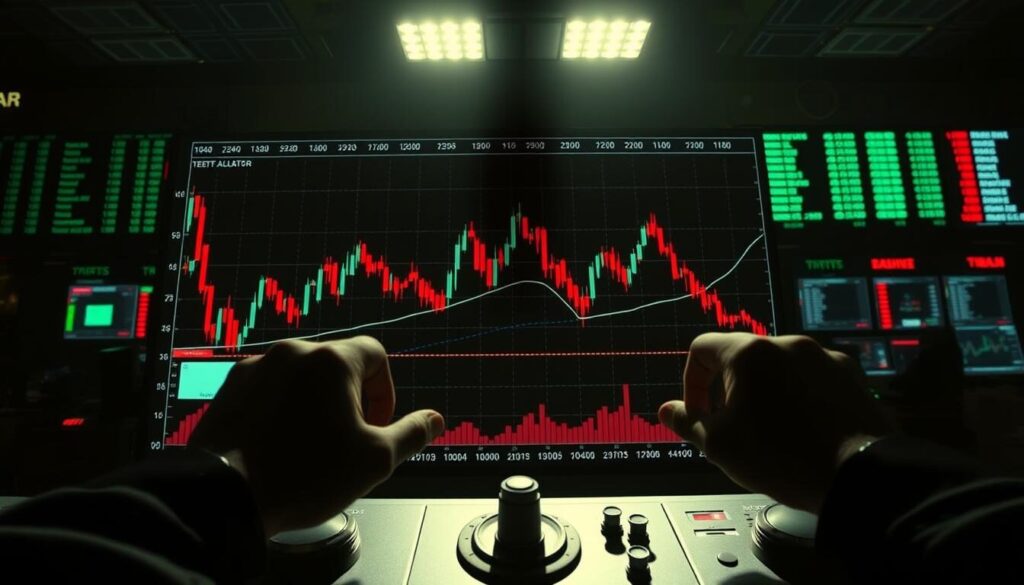Picture this: every day, over $7.5 trillion changes hands in a marketplace with no physical address. Yet rumors swirl like confetti—could someone rig this invisible game? Let’s cut through the noise.
Think of currency trading like a global group chat. Banks, governments, and even your neighbor’s cousin influence exchange rates. No single “admin” controls the conversation—it’s the ultimate team effort. Prices shift based on real-world drama: inflation reports, election results, or that viral TikTok about avocado shortages.
Here’s the kicker: while shady moves can happen, they’re rarer than a quiet day on Wall Street. Most firms play fair, grabbing rates from multiple sources faster than you can say “moonlighting as a day trader.” It’s like comparing a Vegas casino to your weekly poker night—the stakes differ wildly.
We’re here to separate fact from fiction. By the end, you’ll know how to spot trustworthy platforms (hint: regulation matters) and why “manipulation” often means “someone didn’t read the fine print.” Let’s dive in.
Key Takeaways
- The currency exchange operates like a digital bazaar—no central authority sets rates
- Ethical firms use real-time data from banks and institutions to determine pricing
- Questionable activities usually stem from unregulated platforms, not major players
- Transparency varies—always check a provider’s pricing sources and regulatory status
- This guide helps you navigate myths and build smarter trading habits
Understanding Forex Market Dynamics
Imagine your favorite sports team adjusting tactics mid-game based on weather, injuries, and crowd noise. Currency markets operate similarly—a live ecosystem reacting to countless inputs. Three factors steer this chaos: breaking news, cash flow patterns, and human psychology.
When Headlines Move Money
Economic reports act like caffeine for traders. A strong jobs number? That’s your double espresso—currencies spike faster than a TikTok trend. Geopolitical drama works too. Remember when oil prices tanked during lockdowns? CAD/JPY pairs shook like a malfunctioning vending machine.
“Markets digest news faster than a teenager inhales pizza.”
Central banks play chess while we’re playing checkers. Their rate decisions create ripple effects across currency pairs. Think of it like dominoes: when the Fed hikes rates, emerging market currencies often wobble first.
The Cash Flow Rollercoaster
Liquidity determines whether you’re surfing smooth waves or whitewater rapids. Major pairs like EUR/USD flow like highway traffic at 3 AM. Exotic pairs? More like a crowded mall parking lot during holidays.
- Peak hours: London-New York overlap = tighter spreads
- Thin markets: Orders get filled like rush-hour taxis—slow and pricey
- Volatility spikes: Bid-ask gaps widen like yawning hippos
Smart traders watch liquidity like surfers watch swells. You wouldn’t paddle out during a tsunami warning, right? Same logic applies when economic calendars light up red.
How Forex Brokers Set and Display Prices

Ever wonder how your trading app serves up those flickering numbers? It’s less Wall Street supercomputer, more high-stakes food delivery app. Providers grab ingredients (prices) from multiple restaurants (liquidity sources), then add their secret sauce (markup). Let’s peek into the kitchen.
Your Order: One EUR/USD, Hold the Surprises
Every currency pair has two prices—like a restaurant menu with separate dine-in and takeout rates. The bid is what buyers will pay. The ask is the seller’s minimum. The difference? That’s the spread—the house’s convenience fee.
Top-tier firms mix data from 10+ banks faster than a bartender shaking cocktails. Their tech stacks ping exchanges and dark pools, hunting the juiciest rates. But here’s the rub: some quietly widen spreads during news events—like Uber adding surge pricing during a storm.
| ECN Platforms | Market Makers |
|---|---|
| Aggregate real quotes | Set their own prices |
| Tighter spreads | Fixed spreads |
| Commission fees | Built-in markup |
| Less conflict of interest | May trade against you |
When the Recipe Goes Wrong
Most platforms play nice. But sketchy ones? They’re the hot dog vendors who reuse yesterday’s buns. Watch for:
- Spreads ballooning like soufflés at 8:30 AM ET (NFP report time)
- “Glitches” that only benefit the house
- Quotes drifting from Bloomberg terminal rates
“Good tech should feel like oxygen—invisible but essential.”
Your move: Compare rates across platforms during high liquidity. If your “EUR/USD” price looks fuzzier than a 90s TV screen, someone’s tweaking the knobs. Next, we’ll reveal how to spot when the kitchen’s cutting corners.
Do Forex Brokers Manipulate Prices?

Ever felt your playlist shuffle suspiciously favors certain songs? That’s how price tweaking works in decentralized markets. Unlike stock exchanges with referees, currency trading operates like a 24/7 garage sale—negotiations happen directly between buyers and sellers.
The Volume Knob Analogy
Adjusting spreads is the oldest trick in the book. Imagine turning up your stereo’s bass—suddenly everything sounds different, but the song remains the same. Providers might subtly widen gaps between bid/ask prices during news events. Your stop-loss gets triggered earlier, like dominos falling faster than expected.
Common red flags include:
- Quotes drifting from Reuters/Bloomberg feeds like separated twins
- Spreads ballooning right before interest rate announcements
- “Requote roulette” during high-volatility windows
“Transparent platforms have nothing to hide—their pricing should match third-party sources like GPS coordinates.”
| Ethical Practices | Questionable Moves |
|---|---|
| Real-time bank feeds | Artificial price spikes |
| Fixed commissions | Hidden spread markups |
| Regulatory audits | Unexplained slippage |
Here’s the twist: most firms won’t risk their licenses for petty tricks. Watchdogs like the CFTC pounce faster than cats on laser pointers. Your best defense? Trade major pairs during peak hours—it’s harder to manipulate crowded markets than a sleepy village crossroads.
Pro tip: Compare execution speeds across platforms. If your EUR/GBP trade fills slower than DMV paperwork during lunch hour, someone’s fiddling with the dials.
Recognizing Signs of Market Manipulation

Think of your trading platform as a nightclub bouncer—sometimes the velvet rope gets yanked when you least expect it. Markets hum along smoothly until sudden quirks make you question reality. Here’s how to spot when the rhythm feels off.
Ghosts in the Machine
Slippage hits like a surprise Uber surcharge—you order a ride at $10, but the app charges $12.50. In trading terms, it’s the gap between your expected price and where the trade actually executes. Scalpers hate this more than buffering videos.
Stop hunting? Imagine a trapdoor beneath your feet. Algorithms sniff out clusters of stop-loss orders, then briefly tank prices to trigger them—like shaking apples from a tree. The 2010 Flash Crash saw this on steroids, wiping $1 trillion in minutes before rebounding.
Smoke and Mirrors
Spoofing works like fake concert tickets. Traders place large orders they never intend to fill, tricking participants into reacting. It’s why you might see sudden price spikes that vanish faster than free doughnuts at the office.
| Normal Behavior | Red Flags |
|---|---|
| Gradual spread changes | Bid-ask gaps doubling instantly |
| Consistent execution speeds | Orders taking 5+ seconds during calm periods |
| Prices matching Reuters/Bloomberg | Quotes drifting like lost tourists |
“If your platform’s pricing feels like a magic trick, start asking where the rabbit went.”
Asymmetric slippage stings worst—your losses slip further than gains. Like a vending machine that takes $2 for a $1 soda but never gives change. Always cross-check pricing across platforms. If three apps show EUR/USD at 1.0850 and yours says 1.0835, someone’s thumb is on the scale.
Stay sharp: major news events are playgrounds for mischief. Compare execution logs with independent data feeds—it’s the difference between trusting a weather app and actually looking outside.
Protecting Your Trades and Selecting Reliable Brokers

Choosing a trading partner is like picking a car mechanic—you want someone who won’t “accidentally” find extra problems. Start by treating every platform like a first date: verify credentials before getting serious.
Evaluating Broker Regulation and Transparency
Regulatory licenses are your seatbelt in this wild ride. Look for firms backed by watchdogs like the FCA or CySEC—they’re the hall monitors of finance. Top-tier platforms share their pricing sources like open recipe books. T4Trade? They’re the straight-A student with public audit reports.
| Trust Signals | Red Flags |
|---|---|
| Segregated client funds | Vague fee explanations |
| Real-time execution reports | Withdrawal delays |
| Multiple liquidity partners | No regulatory ID numbers |
Check if banks back their liquidity pools. Platforms partnered with institutions like JP Morgan or Barclays? That’s the financial equivalent of dating someone with references.
Using Demo Accounts and Verifying Third-Party Data
Demo accounts are your free test drives. Notice orders taking longer than a DMV line? That’s your cue to bail. Compare execution speeds during high volatility—if your “EUR/USD” trade slips more than a banana peel, something’s fishy.
“Treat demo mode like a reality show audition—if they flub the rehearsal, imagine the live performance.”
- Cross-check rates with TradingView or Bloomberg terminals
- Track slippage during news events—shouldn’t exceed 2-3 pips on majors
- Search forums for user complaints about unexplained losses
Platforms like Titan FX let you peek under the hood with raw spread data. Still unsure? Third-party review sites are your gossip-free scouts. Remember: real traders spill tea in comment sections.
Conclusion
Navigating currency markets feels like checking the weather—sunny skies can turn stormy fast. While some platforms might tweak spreads like shady Uber surge pricing, most rely on real-time data from global banks. Your profits hinge on spotting the difference between natural market hiccups and intentional foul play.
Think of ethical practices as your trading umbrella. Top-tier platforms show their cards—transparent pricing sources, regulated operations, and execution speeds faster than a caffeine-fueled barista. Compare their conditions like you’d cross-check flight prices. That “too good to be true” spread? Probably is.
Protect your trades with simple armor: demo accounts reveal more than a first date’s Instagram feed. Cross-check rates with third-party tools—if your platform’s quotes drift like a lost kayak, paddle elsewhere. Remember, chart manipulation practices often leave breadcrumbs like inconsistent slippage or phantom price spikes.
Stay sharp—markets reward the informed, not the complacent. Your best edge? Treat every trade like a weather app update: verify, then trust.
